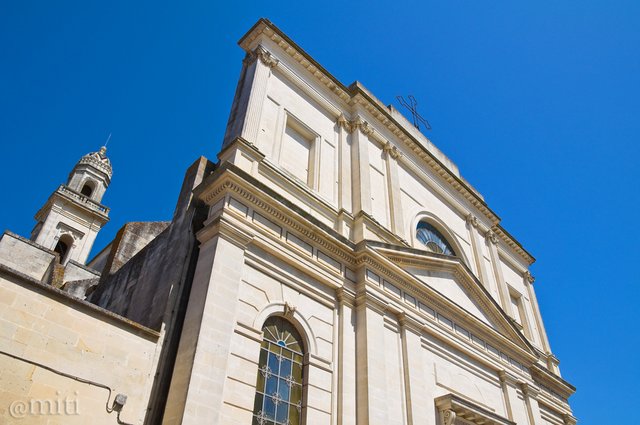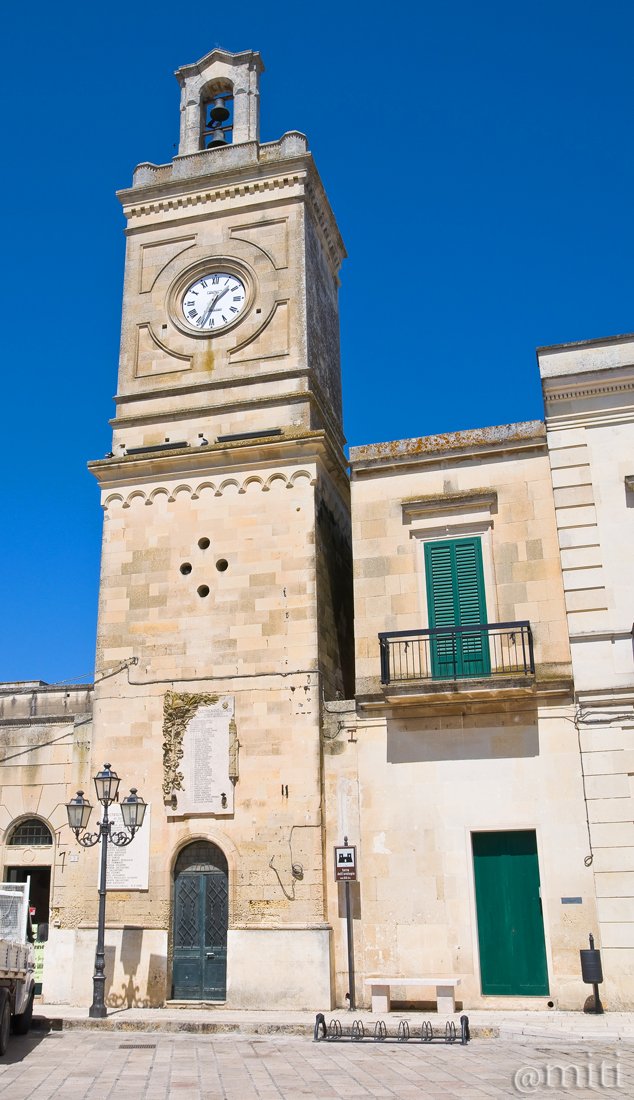A Journey through Italy: one photo every day #136 - CASTRIGNANO DE' GRECI [ENG/ITA]

The Mother Church (Author's photo - All rights reserved)
La Chiesa Madre (Immagine dell'autore - tutti i diritti sono riservati)



Ciao a tutti,
questo è un viaggio attraverso l'Italia. Posterò una foto al giorno con una brevissima descrizione. Spero vi piaccia!

Castrignano de 'Greci è una piccola città in provincia di Lecce, nella regione meridionale italiana della Puglia. È uno dei nove comuni della cosiddetta Grecia Salentina, l'area di lingua greca del Salento.
Non sappiamo esattamente quando e come questo villaggio è stato fondato. Ma le sue origini risalgono a molto indietro nel tempo, assumendo un'atmosfera un po' leggendaria. Secondo alcuni studiosi fu costruita da una Gentilitia romana chiamata "Castrinus"; altri dicono che il suo nome deriva dalla parola latina "castrum" (campo) o dal termine greco "kastron" (castello) in ulteriore conferma del suo stretto legame con la Grecia.
Castrignano mantenne il rito religioso greco fino al 1614 quando Don Menelao Pensa morì. I suoi successori celebrarono la messa con il rito latino. Tuttavia è interessante sapere che nonostante il rito latino fosse quello ufficiale a Castrignano, la messa veniva celebrata secondo il rito greco e la chiesa parrocchiale locale era gestita, per volontà del popolo, dai sacerdoti greci.
Ci sono molte chiese bizantine sparse in tutto il territorio del comune, che sono state distrutte: Santa Maria dei Martiri, S. Stefano, S. Maria delle Puzzelle e S. Anastasia.
Nel medioevo Castrignano fu donato a Pietro Indrimi e in seguito passò nelle mani delle famiglie Prato, Maresgallo e Gualtieri.
Nel centro storico i turisti possono ammirare la cripta bizantina di San Onofrio risalente al VI secolo. Fu costruita da monaci basiliani che probabilmente ingrandirono una grotta naturale preesistente usandola come luogo di culto.
Nel 16 ° secolo la nobile famiglia Gualtieri costruì il suo castello sulle rovine di una fortezza medievale. Il castello ha ancora oggi il nome della famiglia che lo costruì e si erge imponente nel cuore di Castrignano De 'Greci.
Durante le invasioni saracene, il castello dei Gualteri era considerato uno dei più sicuri della zona. Al suo interno, anche grazie a un fossato che lo circondava, la vita di corte era tranquilla e autosufficiente, perfino legislativa: i soldati sorvegliavano le scuderie, un forno e capienti magazzini per i viveri.
È stato modificato nel corso dei secoli, abbellendolo con decorazioni, come il portale, decorato all'interno con angeli, maschere e motivi floreali, che presentano lo splendore del piano nobile. Il Castello De Gualtieris, quasi completamente ristrutturato, è oggi sede di eventi culturali.
L'attuale Chiesa Madre dedicata alla "Madonna dell'Annunziata" fu costruita da Rocco Stomeo nel 1878 du indicazione dell'architetto leccese Federico Elmo. Al suo interno è possibile ammirare nove preziosi affreschi dipinti dal famoso pittore Saverio Altamura di Foggia.
Tra gli altri monumenti vi è la Chiesa della Madonna dell'Arona (1731), la Chiesa dell'Immacolata (1650), la Torre dell'Orologio costruita nello stesso luogo dove una volta c'era una torre preesistente che potrebbe aver ispirato lo stemma del comune.
Nel Parco di Pozzelle ci sono alcuni pozzi (in buono stato di conservazione), circa un centinaio, che un tempo soddisfacevano il fabbisogno idrico della popolazione locale.
L'attuale storia del comune parla di un progetto di protezione e miglioramento della lingua e della cultura ellenica nell'Italia meridionale: la lingua Grika, un tempo particolarmente utilizzata in queste aree, andò progressivamente perdendosi, in particolare a causa delle massicce migrazioni avvenute dopo la seconda guerra mondiale. La mancanza di un serio archivio scritto e l'impoverimento della tradizione popolare hanno portato alla nascita di movimenti per la difesa della cultura e delle tradizioni greche che stanno coinvolgendo un numero crescente di comuni di questa zona della Puglia.
*** Da vedere: *** il Centro storico, il Castello De Gualtieris, la Chiesa Madre, la Cripta Bizantina di S. Onofrio, la Chiesa Madre, la Chiesa della Madonna dell'Arcona, la Chiesa dell'Immacolata , la Torre dell'Orologio, il Parco delle Pozzelle.

Hello everyone,
I began a Photo Journey through Italy. I will post one photo every day with a little note of explanation. I hope you like it!

Castrignano de' Greci is a small town in the province of Lecce, in the southern Italian region of Puglia. It is one of the nine municipalities of the so-called Grecia Salentina, the Greek speaking area of Salento.
We do not know exactly when the and how this village was founded. But its origins go far back in time, taking on a somewhat legendary atmosphere. According to some scholars it was built by a Gentilitia Roman named "Castrinus" ; others say that ist name comes from the Latin word "castrum" (camp) or from the Greek term "kastron" (castle) in further confirmation of itsclose link with Greece.
Castrignano kept the Greek religious rite untill 1614 when Don Menelao Pensa died. His successors celebrated Mass with the Latin rite. However it is interesting to know that notwithstanding the latin rite was the official one in Castrignano Mass was said accordingto the Greek rite and the local Parish Church was run, for the will of the people, by Greek priests.
There are many Byzantine churches scattered throughout the territory of the municipality, which were destroyed: Santa Maria dei Martiri, S. Stefano, S. Maria delle Puzzelle and S. Anastasia.
In the Middle Ages, Castrignano was donated to Peter Indrimi and later passed into the hands of the Prato, Maresgallo and Gualtieri families.
In the historic centre tourists can admire the Byzantine Crypt of St. Onofrio which dates back to the 6th century. It was built by Basilian monks who probably enlarged a pre-existing natural cave using it as a worship place.
In the 16th century the noble family Gualtieri built its castle on the ruins of a medieval fortress. The castle has still nowadays the name of the family who built it and it stands imposing in the heart of Castrignano De’ Greci.
During Saracen invasions, De Gualteris Castle was considered one of the safest in the area. Inside it, also thanks to a moat which used to surround it, the court life was quiet and independent, also speaking about lows: soldiers guarded the studs, an oven and large storehouses for food.
It has been changed over the centuries, embellishing it with decorations, such as the portal, decorated inside with angels, masks and flower motifs, presenting the splendour of the piano nobile (main floor). De Gualtieris Castle , almost completely restructured, is nowadays a place for cultural events.
The present Mother Church dedicated to the "Madonna of the Annunziata" was built by Rocco Stomeo in 1878 on the leccese architect Federico Elmo. Inside it you can admire nine precious frescoes painted by the famous painter Saverio Altamura of Foggia.
Among the other monuments there is the Church of the Madonna of the Arcona (1731), the Church of the Immacolata (1650), the Clock Tower built in the same place were once there was a pre-existing tower which may have inspired the coat of arms of the commune.
In the Pozzelle Park there are some wells (in a good state of preservation), about one hundred which once satisfied the water needs of the local population.
The present history of the municipality tells of a Hellenic language and culture protection and improvement project in southern Italy: the Grika language, once particularly used in these areas, was gradually lost, particularly due to the massive migrations that took place after World War II. The lack of a serious written archive and the impoverishment of the popular tradition have led to the birth of movements for the defence Greek culture and traditions that are involving an increasing number of municipalities of this area of Apulia.
Thing to see: the Historical centre, the De Gualtieris Castle, the the Mother Church, the Byzantine Crypt of St. Onofrio, the Mother Church, the Church of the Madonna of the Arcona, the Church of the Immacolata, the Clock Tower, the Pozzelle Park.

| Tipo di foto / Category | Paesaggio / Landscape view |
| Esposizione / Settings | 1/400 sec, ISO 200, f/11 |
| Camera | Nikon D5000 |
| Lente / Lens | Tamron SP 17-50mm f/2.8 XR Di II LD |
| Filtro / Filter | Polarizzatore Hoya / Hoya Polarizing filter |
| Cavalletto / Tripod | Manfrotto MKC3-P01 |
| Località / Location | Castrignano de' Greci (Lecce), Italia |
| Software | Photoshop |


The Clock Tower (Author's photo - All rights reserved)
La torre dell'Orologio (Immagine dell'autore - tutti i diritti sono riservati)
ne hao
Congratulations, Your Post Has Been Added To The Steemit Worldmap!
Author link: http://steemitworldmap.com?author=miti
Post link: http://steemitworldmap.com?post=a-journey-through-italy-one-photo-every-day-136-castrignano-de-greci-eng-ita
Want to have your post on the map too?
Molto curioso ed originale come l'amministrazione cittadina abbia voluto recuperare la tradizione lasciata dalla Magna Grecia.
Posted using Partiko Android
Si, diciamo che è una rivendicazione di identità..
@miti Congratulations Awesome photography i love traveling in fogrien country Italy is a awesome country
I am from India
India is awesome too!
You got a 50.79% upvote from @ocdb courtesy of @miti!
I like the angular graphic and the beige tone on the first photo, how about cutting the blue part from the right in a more square format to put the canvas angle into play?
An interesting suggestion.. thank you ;-)
Beautiful Photography 👍❤️
Posted using Partiko Android
Thanks.
very beautiful looking clock tower...i really like it!!❤😊❤ beautiful views; Really awesome capture!!
Thank you!
Beautiful Photo nice shot!
Have a nice journey sir ..
Amazing photographs of Italy.
Thank you!